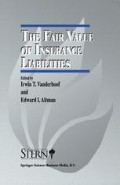Abstract
Traditional life company appraisal methods use projections of reported profit rather than of cash flow, and use discount rates typically selected without any theoretical underpinning. The theme of this paper is that life company valuation can be based on an analysis of the characteristics of the individual cash flows which form the net cash flow. Projected future cash flows may be compared with the income and gains expected from traded securities, such as common stock and government bonds, in order to assess their values. Individual rather than overall cash flows are selected for this market value based analysis because of their generally simpler distribution characteristics. Cash flow interactions are taken account of separately. Standard asset pricing models enable one to allow for lapse, mortality and other risks, and for option features. The resulting overall value is an estimate of the value of future returns discounted at risk rate(s) consistent with the estimated risk/return trade-off implicit in the capital markets.
Comment: This is an adaptation of a paper previously published in the Journal of the Institute. It is an attempt to wed the valuation process to modern financial theory so that valuations may be based upon more realistic discount rates etc. — Ed.
This paper is based on Allowing for asset, liability and business risk in the valuation of a life office. Journal of the Institute of Actuaries, 119, 1992, 385–455, and is included with permission of the Institute of Actuaries.
Access this chapter
Tax calculation will be finalised at checkout
Purchases are for personal use only
Preview
Unable to display preview. Download preview PDF.
References
Bangert, R.M. (1973). Valuation of a life assurance company for purchase. Journal of the Institute of Actuaries, 99, 131.
Beenstock, M. and V. Brasse (1986). Using options to price maturity guarantees. Journal of the Institute of Actuaries, 113, 151.
Black, F. and M.J. Scholes (1973). The pricing of options and corporate liabilities. Journal of Political Economy, 81, 637.
Breedon, D. (1979). An intertemporal asset pricing model with stochastic consumption and investment opportunities. Journal of Financial Economics, 7, 265.
Burrows, R.P. and G.H. Whitehead (1987). The determination of life company appraisal values. Journal of the Institute of Actuaries, 114, 411.
Chew, D.H. and J.M. Stern (1986). The Revolution in Corporate Finance. Oxford: Basil Blackwell. Clarkson, R.S. (1989). The measurement of investment risk. Journal of the Institute of Actuaries, 116, 127.
Copeland, T.E. and F.J. Weston (1983). Financial Theory and Corporate Policy. Addison-Wesley.
Cox, J., Ingersoll, J. and S. Ross (1981). A reexamination of traditional hypotheses about the term structure of interest rates. Journal of Finance, 36, 769.
Cox, J. and M.V. Rubinstein (1985). Option Markets. New York: Prentice-Hall.
Elton, E.J. and M.J. Gruber (1991). Modern Portfolio Theory and Investment Analysis. Chichester: John Wiley and Sons.
Fama, E.F. (1977). Risk-adjusted discount rates and capital budgeting under uncertainty. Journal of Financial Economics, 5, 3.
Hull, J.C. (1993). Options, Futures, and Other Derivative Securities. New York: Prentice-Hall. Lintner, J. (1965). The valuation of risk assets and the selection of risky investments in stock portfolios and capital budgets. Review of Economics and Statistics, XLVII(1), 13.
Markowitz, H.M. (1952). Portfolio selection. Journal of Finance, VII, 77.
Merton, R. (1973). Theory of rational option pricing. Bell Journal of Economics and Management Science, 4, 141.
Miller, M. and F. Modigliani (1958). The cost of capital, corporation finance and the theory of investment. American Economic Review, 53, 261.
Miller, M. and F. Modigliani (1961). Dividend policy, growth and valuation of shares. Journal of Business, 34, 411.
Pepper, G.T. (1984). The long-term future of interest rates both real and nominal. Journal of the Institute of Actuaries, 39, 145.
Platt, R.B. (1986). Controlling Interest Rate Risk: New Techniques and Applications for Money Management. Chichester: John Wiley and Sons.
Report of the Maturity Guarantees Working Party (1980). Journal of the Institute of Actuaries, 107, 101.
Ross, S.A. (1976). The arbitrage theory of capital asset pricing. Journal of Economic Theory, 341.
Sharpe, W.F. (1964). Capital asset prices: a theory of market equilibrium under considerations of risk. The Journal of Finance, XIX, 425.
Sherris, M. (1987). On the risk adjusted discount rate for determining life company appraisal values. Journal of the Institute of Actuaries, 114, 581.
Wilkie, A.D. (1987). An option pricing approach to bonus policy. Journal of the Institute of Actuaries, 114, 21.
Wise, A.J. (1984). The matching of assets to liabilities. Journal of the Institute of Actuaries, 111, 445.
Dixit, A. and R. Pindyck (1994). Investment Under Uncertainty. Princeton University Press.
Hull, John C. (1997). Options, Futures, and Other Derivatives. Third Edition. Prentice Hall.
Rubinstein, M. (1976). The valuation of uncertain income streams and the pricing of options. BellJournal of Economics and Management Science, 7, 407–425.
Author information
Authors and Affiliations
Editor information
Editors and Affiliations
Rights and permissions
Copyright information
© 1998 Springer Science+Business Media Dordrecht
About this chapter
Cite this chapter
Mehta, S., Boyle, P. (1998). Allowing for asset, liability and business risk in the valuation of a life company. In: Vanderhoof, I.T., Altman, E.I. (eds) The Fair Value of Insurance Liabilities. The New York University Salomon Center Series on Financial Markets and Institutions, vol 1. Springer, Boston, MA. https://doi.org/10.1007/978-1-4757-6732-2_5
Download citation
DOI: https://doi.org/10.1007/978-1-4757-6732-2_5
Publisher Name: Springer, Boston, MA
Print ISBN: 978-1-4419-5178-6
Online ISBN: 978-1-4757-6732-2
eBook Packages: Springer Book Archive

